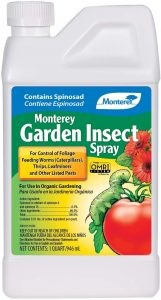Insecticide For Thrips
Thrips congregate by the hundreds and leave black, varnish-like fecal deposits on the underside of leaves. To feed, they puncture the epidermal layer of the host plant with their single large mandible, then slurp the cell sap as it flows into the wound. As a result of their feeding, the foliage appears dusty or silver and dull. Some species may burrow between the upper and lower leaf surfaces to feed. Blossoms can become streaked with brown and can wither prematurely. Injured leaves are twisted or discolored and scarred. The fruit of host plants is often pitted. A few species are beneficial predators of mites and small insects including other thrips, and some feed on fungal spores. Several species may bite people. Some species act as vectors of plant disease. Thrips are poor fliers, so that damage may first appear in one location and then slowly spread over the plant. Thrips will be most apparent on flowers, especially white, yellow, and other light-colored blooms.
Life Cycle
Eggs are inserted into leaves, fruit, stems, or the bark of trees and shrubs. One to two weeks later, pale, wingless nymphs emerge and feed actively until they pupate. Some species enclose the pupa in a cocoon on the ground or on the host plant. The winged adult thrips emerge from the cocoon or pupal stage. Generations may occur every two to three weeks, but the largest populations are present from late spring to midsummer. Thrips overwinter in the egg stage.
Integrated Pest Management Strategies
1. Knock off thrips with a forceful spray of cold water in small gardens, preferably early in the morning. Use a nozzle that produces a fine spray of water, and thoroughly wash off the undersides of affected leaves. The control is most effective when repeated at least 3 times, either daily or every other day.
2. Keep plants well irrigated and adequately misted since thrips prefer a dry environment.
3. Prune and destroy injured and infested plants. Do not compost them.
4. Predacious spiders, mites, and pirate bugs help control thrips. Conserving naturally occurring populations of beneficial insects by avoiding persistent pesticides is important to biologically controlling thrips.
5. Aluminum foil and other disorienting mulches have been used with some success to reduce thrips infestations.
6. Two applications of pyrethrum applied 3 to 4 days apart will treat serious infestations.
7. Insecticidal soaps are effective for temporary reduction of thrips populations. Spray every 3 days for 2 weeks. To control iris thrips, spray insecticidal soap at the base of each plant every 5 to 7 days until the infestation has been controlled. To prevent thrips problems, soak iris divisions and gladiolus corms for 30 minutes in a hot water bath (110–125 degrees F). Dig up gladiolus bulbs early in the fall and let them cure in open trays in a shady location with good air flow such as a garage for a few weeks before soaking them. Then allow the bulbs to dry thoroughly before storing.
8. Spray infested plants with a systemic insecticide such as imidacloprid (Merit) since thrips frequently burrow inside the plant tissue.
9. If necessary, use chemical insecticides such as acephate (Orthene), bifenthrin, imidacloprid, or spinosad. Spray 2 or more times at intervals of 7-10 days to control thrips as they hatch.
Insecticide For Thrips
Thrips are tiny insects that can quickly destroy your garden. They can be difficult to spot, but they do have distinctive markings. You should keep an eye out for their characteristic black-and-white stripes, which make them easy to identify.
Thrips feed on plants by sucking the sap from their leaves and stems. This can cause the leaves to curl or wilt, and also makes it harder for your plants to photosynthesize. Thrips will often form colonies in your garden, so if you see one of these insects on your plant, look around carefully—you may see more there!
You may be able to tell the difference between thrips and aphids by looking at their size: thrips are smaller than aphids, who tend to be bigger and rounder.
If you think you have thrips in your garden, don’t panic! There are several products available for treating them so that they won’t damage your plants further.
List Of Insecticide For Thrips
- Spotted wing drosophila (SWD) management
- Manage resistance, ideal for insect resistance management (IRM) programs
- O-day pre-harvest interval (PHI), 4-hour re-entry interval (REI), OMRI and NOP listed
- Approved for Organic Use
Additional Info :
- Avid, an industry-leading miticide/insecticide, controls mites and leafminers and provides suppression of aphids, thrips and whiteflies.
- Formulated for easy application
- Highly versatile and Broad-spectrum
- Effective on both foliage and flowers and is an ideal product for a wide variety of application sites, resulting in less products to keep in inventory
- Suppresses other key insect populations while controlling all key ornamental mites with fewer tank mixes
- Rapid movement throughout the entire leaf provides longer protection and is well suited for use in Integrated Crop Management programs
- The date printed on the item is the release date of the item and not the expiration date
Additional Info :
| Item Dimensions | |
| Height | 6 Inches |
| Width | 1.5 Inches |
| Length | 3.75 Inches |
| Weight | 0.58 Pounds |
- Venerate CG to control aphids, leafhopper, lygus, stink bug, thrips & more
Additional Info :
| Color | White |
- Spotted wing drosophila (SWD) management
- Manage resistance, ideal for insect resistance management (IRM) programs
- O-day pre-harvest interval (PHI), 4-hour re-entry interval (REI), OMRI and NOP listed
- Approved for Organic Use
Additional Info :
Additional Info :





